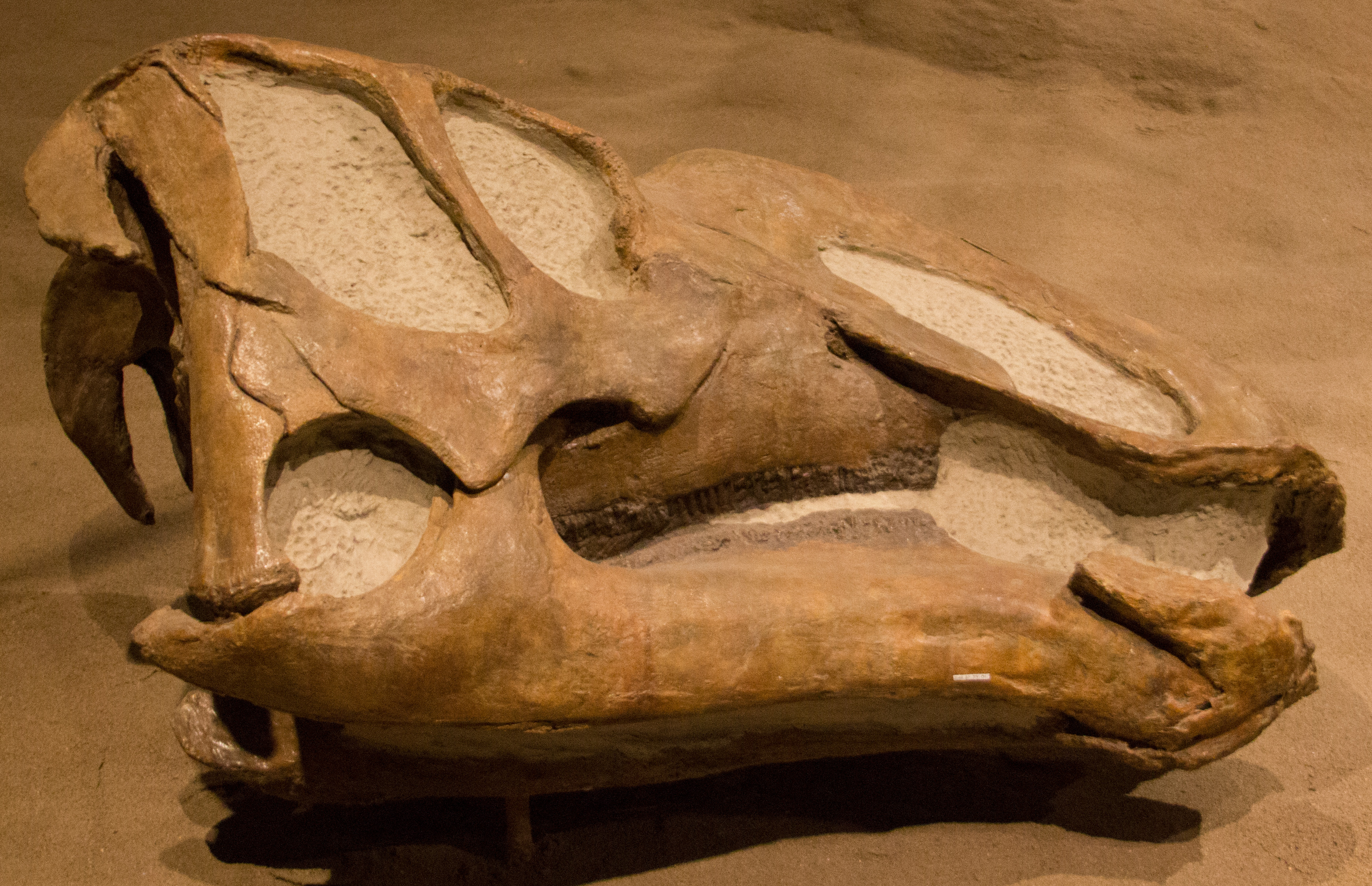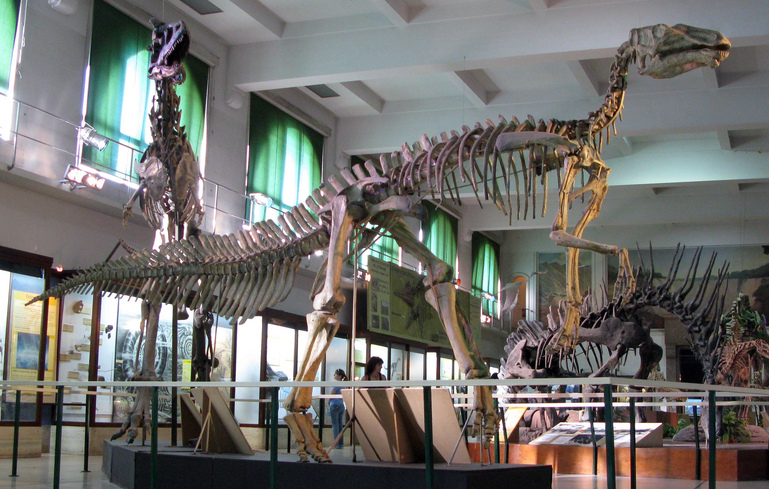|
Kritosaurini
Kritosaurini is a tribe of saurolophine hadrosaurid dinosaurs from the Late Cretaceous. Discovery and naming The first member of the group discovered and named was ''Kritosaurus''; it was named by paleontologist Barnum Brown in 1910. Four years later, Canadian paleontologist Lawrence Lambe would name ''Gryposaurus''. The similarity between the two taxa was immediately recognized, and throughout the twentieth century the validity of the latter genus was doubted, with it being suggested both species were the same. Only in the 1990s were they definitively identified as distinct. Around this time, related hadrosaurs ''Naashoibitosaurus'' and '' Secernosaurus'' were discovered, and the modern interpretation of the group started to develop. Kritosaurini as a tribe was first proposed by Michael Brett-Surman in 1989. It was first defined as a clade in 2014 by Albert Prieto-Márquez as "The most exclusive clade of hadrosaurids containing ''Kritosaurus navajovius'' Brown, 1910, ''Grypo ... [...More Info...] [...Related Items...] OR: [Wikipedia] [Google] [Baidu] |
Kritosaurus
''Kritosaurus'' is an incompletely known genus of hadrosaurid (duck-billed) dinosaur. It lived about 74.5-66 million years ago, in the Late Cretaceous of North America. The name means "separated lizard" (referring to the arrangement of the cheek bones in an incomplete type skull), but is often mistranslated as "noble lizard" in reference to the presumed "Roman nose" (in the original specimen, the nasal region was fragmented and disarticulated, and was originally restored flat). History of discovery In 1904, Barnum Brown discovered the type specimen (AMNH 5799) of ''Kritosaurus'' near the Ojo Alamo Formation, San Juan County, New Mexico, United States, while following up on a previous expedition. He initially could not definitely correlate the stratigraphy, but by 1916 was able to establish it as from what is now known as the late Campanian-age De-na-zin Member of the Kirtland Formation. When discovered, much of the front of the skull had either eroded or fragmented, and Brow ... [...More Info...] [...Related Items...] OR: [Wikipedia] [Google] [Baidu] |
Gryposaurus Notabilis
''Gryposaurus'' (meaning "hooked-nosed (Greek ''grypos'') lizard"; sometimes incorrectly translated as " griffin (Latin ''gryphus'') lizard") was a genus of duckbilled dinosaur that lived about 80 to 75 million years ago, in the Late Cretaceous (late Santonian to late Campanian stages) of North America. Named species of ''Gryposaurus'' are known from the Dinosaur Park Formation in Alberta, Canada, and two formations in the United States: the Lower Two Medicine Formation in Montana and the Kaiparowits Formation of Utah. A possible additional species from the Javelina Formation in Texas may extend the temporal range of the genus to 66 million years ago. ''Gryposaurus'' is similar to ''Kritosaurus'', and for many years the two were thought to be synonyms. It is known from numerous skulls, some skeletons, and even some skin impressions that show it to have had pyramidal scales projecting along the midline of the back. It is most easily distinguished from other duckbills by its ... [...More Info...] [...Related Items...] OR: [Wikipedia] [Google] [Baidu] |
Gryposaurus
''Gryposaurus'' (meaning "hooked-nosed (Greek ''grypos'') lizard"; sometimes incorrectly translated as "griffin (Latin ''gryphus'') lizard") was a genus of duckbilled dinosaur that lived about 80 to 75 million years ago, in the Late Cretaceous (late Santonian to late Campanian stages) of North America. Named species of ''Gryposaurus'' are known from the Dinosaur Park Formation in Alberta, Canada, and two formations in the United States: the Lower Two Medicine Formation in Montana and the Kaiparowits Formation of Utah. A possible additional species from the Javelina Formation in Texas may extend the temporal range of the genus to 66 million years ago. ''Gryposaurus'' is similar to '' Kritosaurus'', and for many years the two were thought to be synonyms. It is known from numerous skulls, some skeletons, and even some skin impressions that show it to have had pyramidal scales projecting along the midline of the back. It is most easily distinguished from other duckbills by its ... [...More Info...] [...Related Items...] OR: [Wikipedia] [Google] [Baidu] |
Saurolophinae
Saurolophinae is a subfamily of hadrosaurid dinosaurs. It has since the mid-20th century generally been called the Hadrosaurinae, a group of largely non-crested hadrosaurs related to the crested sub-family Lambeosaurinae. However, the name Hadrosaurinae is based on the genus '' Hadrosaurus'' which was found in more recent studies to be more primitive than either lambeosaurines or other traditional "hadrosaurines", like ''Edmontosaurus'' and ''Saurolophus''. As a result of this, the name Hadrosaurinae was dropped or restricted to ''Hadrosaurus'' alone, and the subfamily comprising the traditional "hadrosaurines" was renamed the Saurolophinae. Recent phylogenetic work by Hai Xing indicates that '' Hadrosaurus'' is placed within the monophyletic group containing all non-lambeosaurine hadrosaurids. Under this view, the traditional Hadrosaurinae is resurrected, with the Hadrosauridae being divided into two clades: Hadrosaurinae and Lambeosaurinae. Saurolophinae was first defined a ... [...More Info...] [...Related Items...] OR: [Wikipedia] [Google] [Baidu] |
Secernosaurus
''Secernosaurus'' (meaning "severed lizard") is a genus of herbivorous dinosaur. ''Secernosaurus'' was a hadrosaur, a "duck-billed" dinosaur which lived during the Late Cretaceous. ''Secernosaurus'' and its close relatives lived in South America, unlike most hadrosaurs, which lived in the Laurasian continents of Eurasia and North America. It has been suggested that the ancestors of ''Secernosaurus'' crossed into South America when a land bridge temporarily formed between North and South America during the Late Cretaceous and allowed biotic interchange between the two continents. History of research The holotype of ''Secernosaurus koeneri'' was collected in 1923 as part of an expedition by the Field Museum led by J. B. Abbott. However, the specimen was not studied until the 1970s. In 1979, Brett-Surman named ''Secernosaurus''. Though hadrosaurid specimens from South America had been described before, ''Secernosaurus koeneri'' was the first species of South American hadrosaurid to ... [...More Info...] [...Related Items...] OR: [Wikipedia] [Google] [Baidu] |
Acristavus
''Acristavus'' (meaning "non-crested grandfather") is a genus of saurolophine dinosaur. Fossils have been found from the Campanian Two Medicine Formation in Montana and Wahweap Formation in Utah, United States. The type species ''A. gagslarsoni'' was named in 2011. Unlike nearly all hadrosaurids except ''Edmontosaurus'', ''Acristavus'' lacked ornamentation on its skull. The discovery of ''Acristavus'' is paleontologically significant because it supports the position that the ancestor of all hadrosaurids did not possess cranial ornamentation, and that ornamentation was an adaptation that later arose interdependently in the subfamilies Saurolophinae and Lambeosaurinae. It is closely related to '' Brachylophosaurus'' and '' Maiasaura'', and was assigned to a new clade called Brachylophosaurini. Discovery and occurrence left, Skull The holotype specimen of ''Acristavus'', MOR 1155, was recovered at the Two Medicine Formation, in Teton County, Montana. The specimen was collect ... [...More Info...] [...Related Items...] OR: [Wikipedia] [Google] [Baidu] |
Huallasaurus
''Huallasaurus'' (meaning "duck lizard") is an extinct genus of saurolophine hadrosaur from the Late Cretaceous Los Alamitos Formation of Patagonia in Argentina. The type and only species is ''H. australis''. Originally named as a species of ''Kritosaurus'' in 1984, it was long considered a synonym of ''Secernosaurus'' before being recognized as its own distinct genus in a 2022 study, different from other members of Kritosaurini. Etymology The generic name, "''Huallasaurus''," combines "hualla," the Mapudungun word for "duck," and the Greek "sauros," meaning "lizard." The specific name, "''australis''," is derived from the Latin "australis," meaning "southern," after the discovery of the holotype specimen in southern Argentina. Phylogeny Depicted below is a reproduction of the phylogenetic tree produced by Rozadilla ''et al''. (2022), including ''Huallasaurus'' and '' Kelumapusaura'', which was described in the same study. Paleoecology ''Huallasaurus'' is known from the ... [...More Info...] [...Related Items...] OR: [Wikipedia] [Google] [Baidu] |
Rhinorex
''Rhinorex'' is a genus of kritosaurin hadrosaur from the Late Cretaceous Neslen Formation, in central Utah. Its exact placement in time is uncertain, though it probably dates to 75 million years ago and was discovered in estuarine sediments. T.A. Gates & R. Scheetz (2014): A new saurolophine hadrosaurid (Dinosauria: Ornithopoda) from the Campanian of Utah, North America ''Journal of Systematic Palaeontology''. doi: 10.1080/14772019.2014.950614 It is likely a close relative of '''', and i ... [...More Info...] [...Related Items...] OR: [Wikipedia] [Google] [Baidu] |
Brachylophosaurus
''Brachylophosaurus'' ( or ; meaning "short-crested lizard", Greek ''brachys'' = short + ''lophos'' = crest + ''sauros'' = lizard, referring to its small crest) was a mid-sized member of the hadrosaurid family of dinosaurs. It is known from several skeletons and bonebed material from the Judith River Formation of Montana, the Wahweap Formation of Utah and the Oldman Formation of Alberta, living about 81-76.7 million years ago. Discovery and later finds ''Brachylophosaurus'' was first named and described by Charles Mortram Sternberg in 1953 for a skull and partial skeleton, holotype NMC 8893, which he had found in 1936 near Steveville in Alberta, and which was at first thought to belong to '' Gryposaurus'' (or '' Kritosaurus'' as it was known at the time). The type species is ''Brachylophosaurus canadensis''. The generic name is derived from Greek βραχύς, ''brachys'', "short", and λόφος, ''lophos'', "crest of a helmet". The specific name refers to the provena ... [...More Info...] [...Related Items...] OR: [Wikipedia] [Google] [Baidu] |
Maiasaura
''Maiasaura'' (from the Greek ''μαῖα'', meaning "good mother" and ''σαύρα'', the feminine form of ''saurus'', meaning "reptile") is a large herbivorous saurolophine hadrosaurid ("duck-billed") dinosaur genus that lived in the area currently covered by the state of Montana and the province of Alberta, Canada in the Upper Cretaceous Period (mid to late Campanian), about 76.7 million years ago.Horner, J. R., Schmitt, J. G., Jackson, F., & Hanna, R. (2001). Bones and rocks of the Upper Cretaceous Two Medicine-Judith River clastic wedge complex, Montana. In Field trip guidebook, Society of Vertebrate Paleontology 61st Annual Meeting: Mesozoic and Cenozoic Paleontology in the Western Plains and Rocky Mountains. Museum of the Rockies Occasional Paper (Vol. 3, pp. 3-14). The first remains of ''Maiasaura'' were discovered in 1978 by Bynum, Montana resident Laurie Trexler. The genus was named in 1979. The name refers to the find of nests with eggs, embryos and young animals, in ... [...More Info...] [...Related Items...] OR: [Wikipedia] [Google] [Baidu] |
Dinosaurs
Dinosaurs are a diverse group of reptiles of the clade Dinosauria. They first appeared during the Triassic period, between 243 and 233.23 million years ago (mya), although the exact origin and timing of the evolution of dinosaurs is the subject of active research. They became the dominant terrestrial vertebrates after the Triassic–Jurassic extinction event 201.3 mya; their dominance continued throughout the Jurassic and Cretaceous periods. The fossil record shows that birds are feathered dinosaurs, having evolved from earlier theropods during the Late Jurassic epoch, and are the only dinosaur lineage known to have survived the Cretaceous–Paleogene extinction event approximately 66 mya. Dinosaurs can therefore be divided into avian dinosaurs—birds—and the extinct non-avian dinosaurs, which are all dinosaurs other than birds. Dinosaurs are varied from taxonomic, morphological and ecological standpoints. Birds, at over 10,700 living species, are am ... [...More Info...] [...Related Items...] OR: [Wikipedia] [Google] [Baidu] |
Hadrosauridae
Hadrosaurids (), or duck-billed dinosaurs, are members of the ornithischian family Hadrosauridae. This group is known as the duck-billed dinosaurs for the flat duck-bill appearance of the bones in their snouts. The ornithopod family, which includes genera such as '' Edmontosaurus'' and '' Parasaurolophus'', was a common group of herbivores during the Late Cretaceous Period. Hadrosaurids are descendants of the Upper Jurassic/Lower Cretaceous iguanodontian dinosaurs and had a similar body layout. Hadrosaurs were among the most dominant herbivores during the Late Cretaceous in Asia and North America, and during the close of the Cretaceous several lineages dispersed into Europe, Africa, South America and Antarctica. Like other ornithischians, hadrosaurids had a predentary bone and a pubic bone which was positioned backwards in the pelvis. Unlike more primitive iguanodonts, the teeth of hadrosaurids are stacked into complex structures known as dental batteries, which acted as eff ... [...More Info...] [...Related Items...] OR: [Wikipedia] [Google] [Baidu] |








